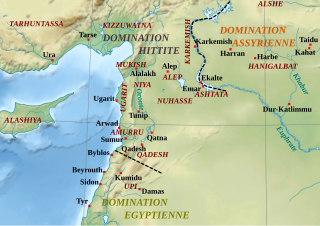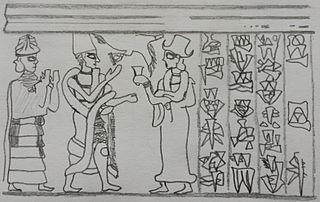Related Research Articles

The Hittites were an Anatolian people who played an important role in establishing first a kingdom in Kussara before 1750 BC, then the Kanesh or Nesha kingdom, and next an empire centered on Hattusa in north-central Anatolia around 1650 BC. This empire reached its height during the mid-14th century BC under Šuppiluliuma I, when it encompassed an area that included most of Anatolia as well as parts of the northern Levant and Upper Mesopotamia.

The Hurrians were a people of the Bronze Age Near East. They spoke a Hurro-Urartian language called Hurrian and lived in Anatolia, Syria and Northern Mesopotamia. The largest and most influential Hurrian nation was the kingdom of Mitanni, its ruling class perhaps being Indo-Iranian speakers. The population of the Indo-European-speaking Hittite Empire in Anatolia included a large population of Hurrians, and there is significant Hurrian influence in Hittite mythology. By the Early Iron Age, the Hurrians had been assimilated with other peoples. Their remnants were subdued by a related people that formed the state of Urartu. The present-day Armenians are an amalgam of the Indo-European groups with the Hurrians and Urartians.

Kültepe, also known as Kanesh or Nesha, is an archaeological site in Kayseri Province, Turkey. The nearest modern city to Kültepe is Kayseri, about 20 km southwest. It consists of a tell, the actual Kültepe, and a lower town, where an Assyrian settlement was found. Its ancient names are recorded in Assyrian and Hittite sources. In Old Assyrian inscriptions from the 20th and the 19th century BCE, the city was mentioned as Kaneš (Kanesh); in later Hittite inscriptions, the city was mentioned as Neša, or occasionally as Aniša (Anisha). In 2014, the archaeological site was inscribed in the Tentative list of World Heritage Sites in Turkey. It is also the site of discovery of the earliest traces of the Hittite language, the earliest attestation of an Indo-European language, dated to the 20th century BCE.

Mitanni, also called Hanigalbat or Hani-Rabbat in Assyrian or Naharin in Egyptian texts, was a Hurrian-speaking state in northern Syria and southeast Anatolia.

Yamhad was an ancient Semitic kingdom centered on Ḥalab (Aleppo), Syria. The kingdom emerged at the end of the 19th century BC, and was ruled by the Yamhadite dynasty kings, who counted on both military and diplomacy to expand their realm. From the beginning of its establishment, the kingdom withstood the aggressions of its neighbors Mari, Qatna and Assyria, and was turned into the most powerful Syrian kingdom of its era through the actions of its king Yarim-Lim I. By the middle of the 18th century BC, most of Syria minus the south came under the authority of Yamhad, either as a direct possession or through vassalage, and for nearly a century and a half, Yamhad dominated northern, northwestern and eastern Syria, and had influence over small kingdoms in Mesopotamia at the borders of Elam. The kingdom was eventually destroyed by the Hittites, then annexed by Mitanni in the 16th century BC.
Mursili I was a king of the Hittites c. 1620-1590 BC, as per the middle chronology, the most accepted chronology in our times, or alternatively c. 1556–1526 BCE, and was likely a grandson of his predecessor, Hattusili I. His sister was Ḫarapšili and his wife was queen Kali.
Shamshi-Adad was an Amorite who had conquered lands across much of Syria, Anatolia, and Upper Mesopotamia for the Old Assyrian Empire.
Adad-nārārī I, rendered in all but two inscriptions ideographically as mdadad-ZAB+DAḪ, meaning “Adad (is) my helper,” was a king of Assyria during the Middle Assyrian Empire. He is the earliest Assyrian king whose annals survive in any detail. Adad-nārārī I achieved major military victories that further strengthened Assyria. In his inscriptions from Assur he calls himself son of Arik-den-ili, the same filiations being recorded in the Nassouhi kinglist. He is recorded as a son of Enlil-nirari in the Khorsabad kinglist and the SDAS kinglist, probably in error.

Kussara (Kuššar) was a Bronze Age kingdom in Anatolia. The kingdom, though apparently important at one time, is mostly remembered today as the origin of the dynasty that would form the Old Hittite Kingdom.

Nuhašše, also Nuhašša, was a region in northwestern Syria that flourished in the 2nd millennium BC. It was a federacy ruled by different kings who collaborated and probably had a high king. Nuhašše changed hands between different powers in the region such as Egypt, Mitanni and the Hittites. It rebelled against the latter which led Šuppiluliuma I to attack and annex the region.

The Old Assyrian Empire (Sumero-Akkadian cuneiform: 𒆳𒀭𒊹𒆠 KUR AN-ŠAR2KI, Assyrian cuneiform: mat aš-šur KI, "Country of the city of god Aššur"; also phonetically mat da-šur) is the second of four periods into which the history of Assyria is divided, the other three being the Early Assyrian Period (2600–2025 BC), the Middle Assyrian Empire (1392–934 BC), and the Neo-Assyrian Empire (911–609 BC). Assyria was a major Mesopotamian East Semitic-speaking kingdom and empire of the ancient Near East. Centered on the Tigris–Euphrates river system in Upper Mesopotamia, the Assyrian people came to rule powerful empires at several times. Making up a substantial part of the "cradle of civilization", which included Sumer, the Akkadian Empire, and Babylonia, Assyria was at the height of technological, scientific and cultural achievements at its peak.

The Middle Assyrian Empire is the period in the history of Assyria between the fall of the Old Assyrian Empire in the 14th century BC and the establishment of the Neo-Assyrian Empire in the 10th century BC.

The ancient Near East was the home of early civilizations within a region roughly corresponding to the modern Middle East: Mesopotamia, ancient Egypt, ancient Iran, Anatolia/Asia Minor and the Armenian Highlands, the Levant, Cyprus and the Arabian Peninsula. The ancient Near East is studied in the fields of Ancient Near East studies, Near Eastern archaeology and ancient history.
Yarim-Lim I, also given as Yarimlim, was the second king of the ancient Amorite kingdom of Yamhad in modern-day Aleppo, Syria.
Sumu-Epuh is the first attested king of Yamhad (Halab). He founded the Yamhad dynasty which controlled northern Syria throughout the 17th and 18th centuries BC.
Irridu (Irrite) was a city in northwestern Mesopotamia, likely located between Harran and Carchemish. It flourished in the middle and late Bronze Age before being destroyed by Assyria.
Yarim-Lim III was the king of Yamhad (Halab) succeeding Hammurabi II.
Hassum was a Hurrian city-state, located in southern Turkey most probably on the Euphrates river north of Carchemish.

The Yamhad dynasty was an ancient Amorite royal family founded in c. 1810 BC by Sumu-Epuh of Yamhad who had his capital in the city of Aleppo. Started as a local dynasty, the family expanded its influence through the actions of its energetic ruler Yarim-Lim I who turned it into the most influential family in the Levant through both diplomatic and military tools. At its height the dynasty controlled most of northern Syria and the modern Turkish province of Hatay with a cadet branch ruling in the city of Alalakh.

The timeline of the Assyrian Empire can be broken down into three eras: Old Assyrian Empire, Middle Assyrian Empire, and Neo-Assyrian Empire.
References
Citations
- ↑ I. M. Diakonoff (28 June 2013). Early Antiquity. p. 364. ISBN 9780226144672.
- ↑ Noel Freedman; Allen C. Myers (31 December 2000). Eerdmans Dictionary of the Bible. p. 619. ISBN 9789053565032.
- ↑ Mogens Herman Hansen (2000). A Comparative Study of Thirty City-state Cultures: An Investigation, Volume 21. p. 60. ISBN 9788778761774.
- 1 2 Sidney Smith (1956). Anatolian Studies: Journal of the British Institute of Archaeology at Ankara. Special number in honour and in memory of John Garstang, 5th May, 1876 - 12th September, 1956, Volume 6. p. 42.
- ↑ I. E. S. Edwards; C. J. Gadd; N. G. L. Hammond; E. Sollberger (3 May 1973). The Cambridge Ancient History. p. 241. ISBN 9780521082303.
- ↑ Gojko Barjamovic (2011). A Historical Geography of Anatolia in the Old Assyrian Colony Period. p. 200+201. ISBN 9788763536455.
- ↑ Iorwerth Eiddon Stephen Edwards; C. J. Gadd; N. G. L. Hammond (31 October 1971). The Cambridge Ancient History. p. 559. ISBN 9780521077910.
- ↑ Gwendolyn Leick (2 June 2009). The Babylonian World. p. 537. ISBN 9781134261284.
- ↑ Yuhong Wu (1994). A Political History of Eshnunna, Mari and Assyria During the Early Old Babylonian Period: From the End of Ur III to the Death of Šamši-Adad. p. 131.
- ↑ Sidney Smith (1956). Anatolian Studies: Journal of the British Institute of Archaeology at Ankara. Special number in honour and in memory of John Garstang, 5th May, 1876 - 12th September, 1956, Volume 6. p. 39.
- 1 2 Gojko Barjamovic (2011). A Historical Geography of Anatolia in the Old Assyrian Colony Period. p. 202. ISBN 9788763536455.
- ↑ Beatrice Teissier (1996). Egyptian Iconography on Syro-Palestinian Cylinder Seals of the Middle Bronze Age. p. 1. ISBN 9783525538920.
- ↑ J. R. Kupper. The Cambridge Ancient History Northern Mesopotamia and Syria. p. 19.
- ↑ William J. Hamblin (27 September 2006). Warfare in the Ancient Near East to 1600 BC. p. 255. ISBN 9781134520626.
- ↑ Trevor Bryce (March 2014). Ancient Syria: A Three Thousand Year History. p. 27. ISBN 9780199646678.
- ↑ Horst Klengel (20 March 1992). Syria, 3000 to 300 B.C.: a handbook of political history. p. 75. ISBN 9783050018201.
- ↑ Seton Lloyd (21 August 2007). Hittite Warrior. p. 44. ISBN 9781846030819.
- ↑ Robert Drews (1993). The End of the Bronze Age: Changes in Warfare and the Catastrophe Ca. 1200 B.C. p. 106. ISBN 0691025916.
- ↑ I. E. S. Edwards; C. J. Gadd; N. G. L. Hammond; E. Sollberger (3 May 1973). The Cambridge Ancient History. p. 245. ISBN 9780521082303.
- ↑ Seton Lloyd (1999). Ancient Turkey: A Traveller's History. p. 39. ISBN 9780520220423.
- 1 2 Gojko Barjamovic (2011). A Historical Geography of Anatolia in the Old Assyrian Colony Period. p. 203. ISBN 9788763536455.